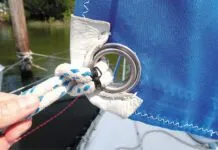What Terminals with Dyform?
Weve just upgraded to roller furling. This included a new 5/8″ Dyform headstay. We used our old Sta-Lok terminal ends, with new wedges, the versions specified for Dyform. The December 1997 issue of Practical Sailor quotes Phil Garland of Hall Spars as saying, Using a mechanical fastener with Dyform is not a good idea. Have we done wrong? Also, please clarify the statement in the same issue that 304 wire is a false economy. Were getting ready to replace our standing rigging, so our interest is keen.
Ted Perkowski
Whangarei, New Zealand
Youve nothing to worry about.
Dyform, which is a registered trademark of British Ropes Limited, was developed by BRL and Norseman Gibb, the makers of the Norseman terminal system that competes with both Sta-Lok and Castlok.
Conventional 1×19 wire rope has a single core wire (called the king wire), surrounded by six more strands, surrounded by the remaining 12 strands (called lay lengths). All strands are the same diameter. Dyform has a single center strand surrounded by nine smaller strands enclosed in nine strands of the same size as the center core. Dyform is then cold rolled, which compresses the bundle and flattens the circumference. The low-stretch Dyform is stronger, but weve always thought that it was because it contains more metal that fits together better and thus creates smaller voids.
To answer your question, Simpson Lawrence, the importers of Sta-Lok, say the Sta-Lok fittings work well on Dyform. A different wedge is used, as you were aware.
As might be expected, because theyre made by the same folks, Norseman fittings are compatible with Dyform wire, according to Navtec Norseman Gibb, the U.S. importers of both.
(In 1993, we pull-tested Norseman, Sta-Lok, Castloc and Quick-Rig fittings to destruction, along with swaged terminals and eyes formed with Nicopress sleeves and standard wire rope clamps. The results were in the May 15, 1993 issue.)
We checked back with Phil Garland at Hall Spars. An expert engineer with an enviable reputation, Garland said that there had been, in that earlier discussion, a misunderstanding about what a mechanical terminal is. He said all types of terminals work with Dyform, but also pointed out that a good swage will take 100% of the wire strength, whereas a Sta-Lok or Norseman will yield about 90% of the wire strength.
Regarding 304 vs. 316 stainless wire, Type 304 is stronger for a given size but is not nearly as corrosion resistant as 316, which costs about 20% more. Wire suppliers and riggers recommend 316, especially for boats kept in warm climes where the saltwater is particularly corrosive.



































